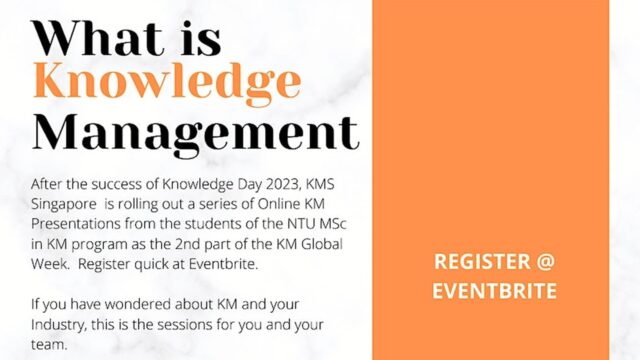
Aligning HR with KM [EKM series]
Editor’s note: This is a continuing serialisation of edited portions of Andre Saito’s PhD.
The growing importance of knowledge work and knowledge workers demands innovative human resources management (HRM) practices and policies. Compared to traditional forms of work, knowledge work is said to have a broader scope, be less predictable, and involve a greater degree of judgment from workers. Thus, it cannot be centrally designed as a set of procedures and cannot be directly managed. Furthermore, knowledge workers seem to have their experience and expertise in high regard, and are motivated mainly by factors like personal growth and peer recognition. Thus, they usually require a significant degree of job autonomy and flexibility, and need different incentive systems to get inspired and committed1.
HRM practices adapted for knowledge work and workers involve, among other things, innovative job design and adequate reward systems. Mohrman2 suggests new principles of work design based on the changing and interdependent nature of knowledge work. She proposes work designs that are dynamic and emphasize systemic performance, focus on sequences of assignments instead of well-defined jobs, cut across functional, geographical and other types of boundaries, and provide experience and develop talent. Lawler3 reviews the impact of different reward systems on the motivation, attraction and retention of knowledge workers. Comparing pay systems based on a job’s functions and responsibilities, a person’s performance and achievements, and a person’s skills and competencies, he argues that the last is more appropriate for knowledge work.
HRM issues in knowledge management
Human and social factors are crucial elements of knowledge management, and many authors argue that HRM practices and policies have an important role in employees’ attitudes and behavior. They can affect issues like employee motivation and commitment, knowledge sharing behavior, and organizational culture, all of which are relevant for KM. An organization’s reward system, for instance, is often taken as a significant element affecting employees’ motivation, encouraging them to put effort on expected outcomes.
Lawler4 shows how alternative systems have different impacts on employees’ behavior. Job-based compensation5 may contribute to easier control and organizational efficiency, but may also discourage risk-taking, learning, and collaboration. Skills-based compensation6, on the other hand, may encourage development and improve flexibility, but hinders market comparison and employee assessment is difficult. Performance-based compensation7 may stimulate better performance by clearly connecting it with rewards, but defining criteria and establishing good measures may be a challenge.
The extent to which HRM practices and policies can create a knowledge-oriented organizational culture is subject to debate. The most likely relationship is a reciprocal influence between them. On the one hand, HRM derives from and is affected by the existing culture. On the other hand, HRM may also affect culture, by reinforcing cultural norms and routines that shape individual attitudes and behaviors.
Alignment of HRM, KM and business strategies
Bierly and Daly8 argue that firms that align their HRM practices with their particular knowledge strategy will be more successful in developing sustainable competitive advantage.
In a previous study, Bierly and Chakrabarti9 categorized firms in four types according to their strategy for managing their knowledge base:
- Explorers: Firms that excel at developing new, radical knowledge but are not strong at exploiting existing knowledge benefit from HRM practices that promote creativity and risk-taking. Examples of these practices include moderate external hiring, results-oriented appraisal, and loose job definitions.
- Exploiters: Firms that successfully exploit existing knowledge areas but are not effective in generating radically new knowledge benefit from HRM practices that promote flexibility, continual improvement, and the integration of tacit knowledge. Examples of these practices include internal hiring, teams, formal training, short-term results-oriented appraisals, and rewards for employee participation.
- Bimodal learners: Firms that excel at developing new, radical knowledge but are also strong at exploiting existing knowledge benefit from HRM practices that promote managing complexity, creativity, and flexibility. Examples of these practices include flexible HRM system, teams, rewards and practices that promote open communications.
- Maintainers: are firms that do not excel at developing new, radical knowledge and are not strong at exploiting existing knowledge benefit from HRM practices that promote stability and rapid socialization of new members. Examples of these practices include internal hiring, formal training, behavioral appraisals, narrow job definitions, and clear career paths.
Next edition: The limitations of the role that information systems can play in effective Knowledge Management.
- Newell et al., 2002; Beaumont & Hunter, 2002 ↩
- Mohrman, S. A. (2003). Designing work for knowledge-based competition. In S. E. Jackson, M. A. Hitt & A. S. DeNisi (Eds.), Managing knowledge for sustained competitive advantage: Designing strategies for effective human resource management (pp. 94-123). San Francisco, CA: Jossey-Bass. ↩
- Lawler, E. E. III (2003). Reward systems in knowledge-based organizations. In S. E. Jackson, M. A. Hitt & A. S. DeNisi (Eds.), Managing knowledge for sustained competitive advantage: Designing strategies for effective human resource management (pp. 274-302). San Francisco, CA: Jossey-Bass. ↩
- Ibid. ↩
- A person is paid for the tasks and responsibilities that her job involves, and people on the same job receive roughly the same pay. Job-based compensation is designed for bureaucratic organizations, where functions are clearly defined and control is exercised through a hierarchical structure. ↩
- A person is paid for her knowledge and skills, and pay increases may come from learning instead of vertical promotions. Skills-based compensation is designed for modular and project-based organizations, where work is decentralized, involves multiple tasks, and is usually team-based. ↩
- There is a variety of ways to pay for performance. It may be individual, team, unit or organization-based. Incentives may be permanent, like increases in salary or stock options, or onetime payments or bonuses, like sales commission or profit sharing. ↩
- Bierly, P. E. III, & Daly, P. (2002). Aligning human resource management practices and knowledge strategies: A theoretical framework. In C. W. Choo & N. Bontis (Eds.), The strategic management of intellectual capital and organizational knowledge (pp. 277-295). Oxford: Oxford University Press. ↩
- Bierly, P., & Chakrabarti, A. (1996). Generic knowledge strategies in the U.S. pharmaceutical industry. Strategic Management Journal, 17(Winter Issue), 123-135. ↩







An effective HRM policy which support KM is a good situation to implement KM effectively but it is not that all. Good HRM may increase employee satisfaction index but may not employee engagement. Any initiative can be implementable if employee engagement is high. So we need to formulate HRM policy keeping in mind increasing engagement. AND still there is push pull effect. Not only HRM but engagement with KM can be mapped to linked to performance index of employee. To implement KM you need both Push and Pull. It can’t be one way.
Thanks to Albert Simard and Ian Fry for these suggested resources in regard to aligning HR and KM:
– Albert’s presentation on the need for a partnership between HR and KM
http://www.slideshare.net/albertsimard/human-resources-and-social-networks-the-future-has-arrived12
– Ian’s post on KM targeting employee capability
https://www.linkedin.com/pulse/has-km-identified-its-true-role-magic-bullet-ian-fry